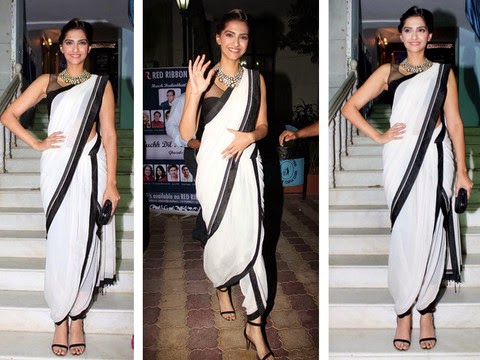Saree is most loved and traditional garment of Indian women. As fashion and trends keeps changing with time women also love to follow latest style to look trendy and gorgeous. So when it comes to draping the saree, women love to experiment with their saree draping styles to look traditionally modern. There are so many styles to drape this unstiched six yard long garment so that one would be amazed to find the versatality of this timeless attire.
.jpg)
1.
Gujarati Style : It is very elegant and traditional style of saree draping. This style of draping is not only adopted in Gujarat but also in Rajasthan, Uttarpradesh, Madhyapradesh, Bihar. Most of the people knows it as "seedha pallu"or "reverse style". It can be draped in any saree. But tradtional gujarati saree increases its beauty and authenticity.

2.
Nivi Style : The Nivi style of Saree draping, popularly known as Ulta Pallu, is the most popular of them all and in practice for long. Nivi style of Saree draping finds its origin in the southern state of Andhra Pradesh. For the locals, it is a traditional form of draping a Saree. This style has become most comon style and represents the cultural heritage of India.

3.
Bengali Style: Saree is the basic attire for women in West Bengal. It is worn on both casual and formal occasions. For every occassion there is a different saree. Like Bengali women Bengali sarees are always appreciated for their beauty. Bengali sarees are so beautiful and can be worn in the traditional or fashionable way. The plain white saree with red and golden border is the classic look of a Bengali woman.

4.
Maharashtra Style: Maharashtrian sarees are unique in its draping style as well in its length as well. While usually we wear six yards saree Marathi saree is of nine yards. It is also called Nauvari. It gives an impression of wearing Dhoti or divided saree. Green glass bangles, nose pin, bindi, gold jewellery and kolhapuri slippers make it perfect.
5.
Coorgi Style: Coorgi Style belongs to Karnataka state of India. It is also called Kodava Attire or Kodagu Style. Traditionally, women are used to wear a matching head scarf along with this saree style called Vastra. This style can be easily recongnised with its pallu and pleats.

6.
Tamillian Style: Tamillian women wear silk sarees on special occassions. This style is called Madisar Pudavai. The madisar pudavai is a long saree wrapped around the body and legs in a trouser style. This style is worn as part of their culture by the women of the Gurukkal, Iyer, and Iyyengar Brahmin communities of Tamil Nadu.
All these different styles are traditional Indian styles of saree draping. All traditional style reflects their respective culture and ethnic background.


.jpg)






